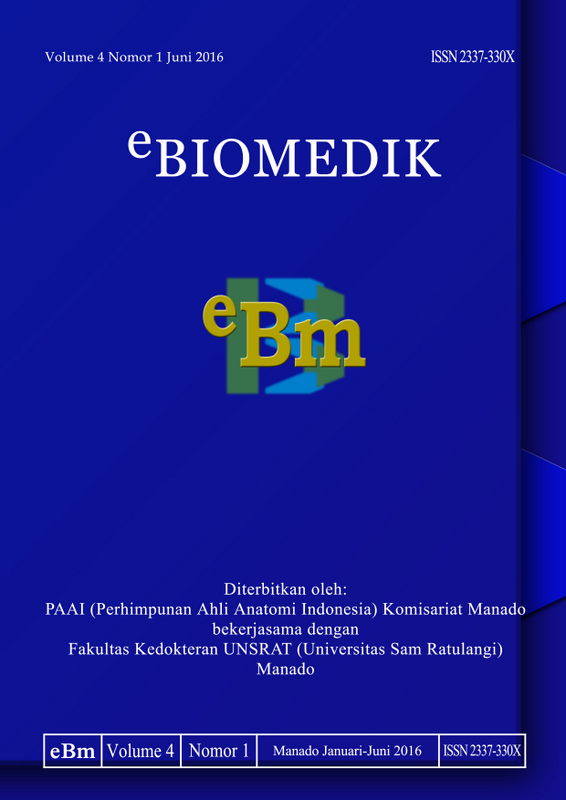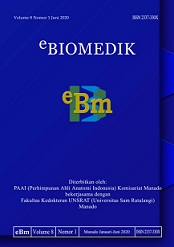ISOLASI DAN IDENTIFIKASI BAKTERI AEROB YANG BERPOTENSI MENJADI SUMBER PENULARAN INFEKSI NOSOKOMIAL DI IRINA A RSUP PROF. DR. R. D. KANDOU MANADO
DOI:
https://doi.org/10.35790/ebm.v4i1.11052Abstract
Abstract: Nosocomial infection or Hospital Acquired Infection (HAI) is an infection caused by bacteria, parasite, or virus in the hospital, infection occur at least 72 hours since hospitalized. This infection occurs due to lack of hygiene of the environment causing microorganism infection from environment to human, infection can also occur due to transmission of microorganism from one patient to other patients. Inpatients potentially have very high risk of nosocomial infection occur due to continuous requiring treatment for more than 24 hours. Purpose: To determine the existence of aerobic bacteria that could potentially be the source of transmission of nosocomial infection in Irina A RSUP Prof. Dr. R. D. Kandou Manado. Method: This research was descriptive with cross sectional approach. Fourteen samples were taken from the surface of medical equipment, bed, floor, and wall of the treatment room and eight samples were taken from the air. Identification of bacteria was performed by culture on agar medium, staining gram, and biochemical test. Result: Bacillus subtilis found in nine samples (41%), Serratia liquefaciens found in five samples (22,7%), Lactobacillus found in two samples (9,1%), Staphylococcus found in two samples (9,1%), Coccus Gram negative found in two samples (9,1%), Enterobacter aerogenes found in one sample (4,5%), and Enterobacter agglomerans found in one sample (4,5%). Conclusion: Bacillus subtilis is the most bacteria which had been found in this research.
Keywords: Aerobic bacteria, Nosocomial infection, Irina A.
Abstrak: Infeksi nosokomial atau Hospital Acquired Infection (HAI) merupakan infeksi yang disebabkan oleh bakteri, parasit, atau virus di rumah sakit, infeksi ini timbul sekurang-kurangnya 72 jam sejak masuk rumah sakit. Infeksi ini terjadi akibat kurang bersihnya lingkungan perawatan menyebabkan terjadinya infeksi mikroorganisme dari lingkungan ke manusia, infeksi juga dapat terjadi akibat berpindahnya mikroorganisme dari pasien yang satu ke pasien yang lain. Pasien ruang rawat inap mempunyai risiko yang sangat tinggi mendapatkan infeksi nosokomial, hal ini dikarenakan pasien pada ruang rawat inap memerlukan asuhan, perawatan dan pengobatan secara berkesinambungan lebih dari 24 jam. Tujuan: Untuk mengetahui adanya bakteri aerob yang berpotensi menjadi sumber penularan infeksi nosokomial di IRINA A RSUP Prof. Dr. R. D. kandou Manado. Metode: Metode penelitian yang digunakan adalah deskriptif dengan pendekatan cross sectional study. Sampel diambil dari 14 usapan permukaan peralatan medis, tempat tidur, lantai, dan dinding ruang perawatan dan delapan sampel dari udara ruang. Identifikasi bakteri dilakukan kultur pada media agar, pewarnaan gram, dan uji biokimia. Hasil: Bacillus subtilis ditemukan sebanyak sembilan sampel (41%), Serratia liquefaciens sebanyak lima sampel (22,7%), Lactobacillus sebanyak dua sampel (9,1%), Staphylococcus sebanyak dua sampel (9,1%), Kokus Gram negatif sebanyak dua sampel (9,1%), Enterobacter aerogenes sebanyak satu sampel (4,5%), dan Enterobacter agglomerans sebanyak satu sampel (4,5%). Kesimpulan: Bacillus subtilis merupakan bakteri yang paling banyak ditemukan.
Kata Kunci: Bakteri aerob, Infeksi nosokomial, Irina A.





